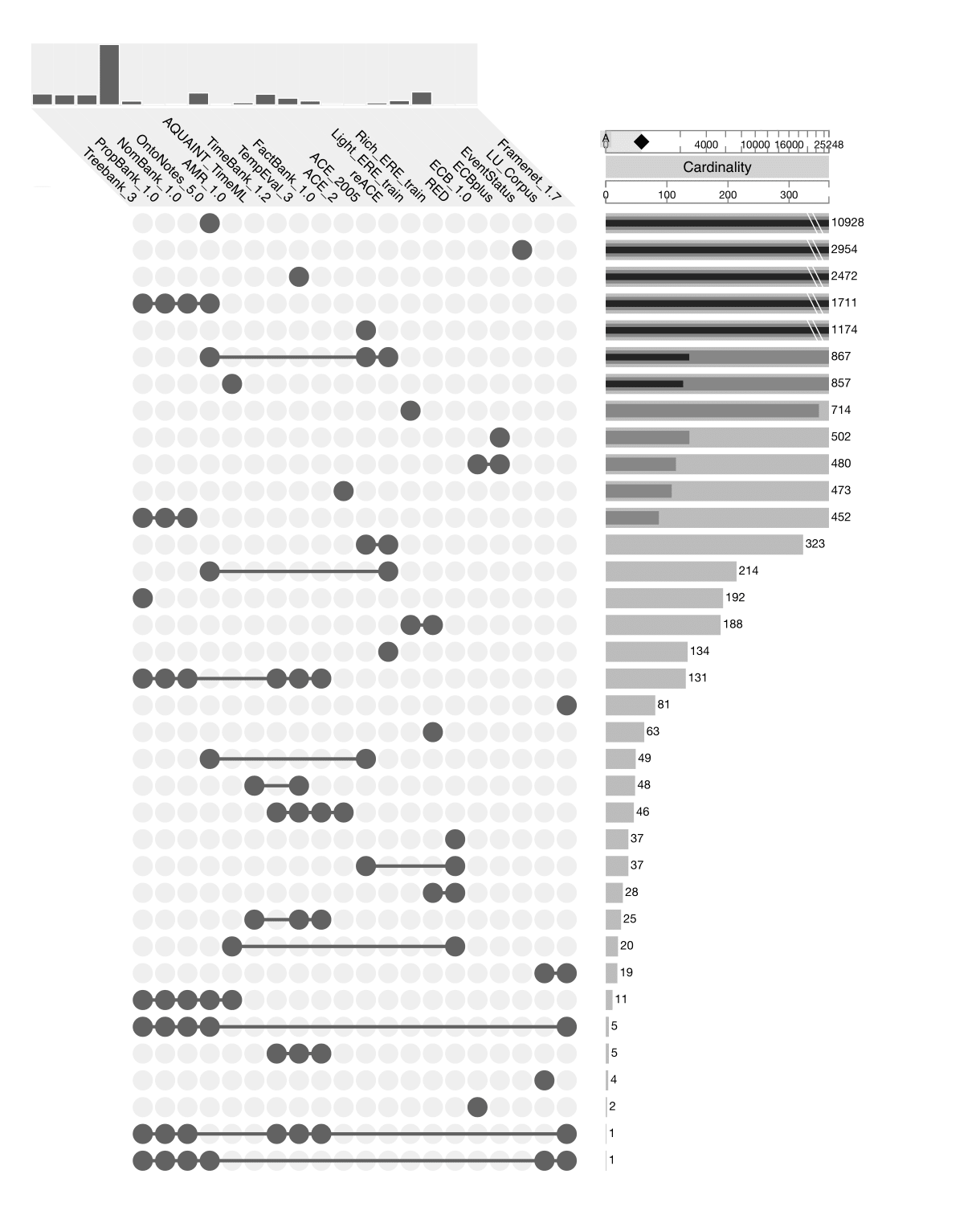Resource Interoperability between Event-Centric Language Resources
This repository contains an overview of the document intersections of language resources. It is described in the following paper:
Chantal van Son, Oana Inel, Roser Morante, Lora Aroyo and Piek Vossen (2018). Resource Interoperability for Sustainable Benchmarking: The Case of Events. In Proceedings of the 11th International Conference on Language Resources and Evaluation (LREC 2018), Miyazaki, Japan. pdf
Language Resources
Currently, the filenames of the following annotated corpora are compared (more corpora may be added in the future):
- Penn TreeBank-3 (LDC99T42)
- Proposition Bank I (LDC2004T14)
- NomBank v1.0 (LDC2008T23)
- OntoNotes Release 5.0 (LDC2013T19)
- FrameNet 1.7 (FrameNet website)
- Abstract Meaning Representation (AMR) Annotation Release 1.0 (LDC2014T12)
- TimeBank 1.2 (LDC2006T08)
- AQUAINT TimeML (ELRA-U-W0394), also available here
- TempEval-3 (Task website)
- FactBank 1.0 (LDC2009T23)
- ACE-2 (LDC2003T11)
- ACE 2005 Multilingual Training Corpus (LDC2006T06)
- Datasets for Generic Relation Extraction (reACE) (LDC2011T08)
- ECB 1.0 Corpus (used to be available here, but link has expired)
- ECB+ Corpus (available at the NewsReader website)
- Richer Event Description (LDC2016T23)
- TDT4 Multilingual Text and Annotations (LDC2005T16)
- Light ERE training data (not officially published yet; see this paper)
- Rich ERE training data (not officially published yet; see this paper)
- The EventStatus Corpus (LDC2017T09)
- The Language Understanding (LU) Annotation Corpus (LDC2009T10)
Note that for all multilingual resources, only the English parts have been taken into account.
For the Penn Treebank and PropBank I have used the ptb package from NLTK to obtain all filenames contained in the corpora. For all other corpora, the analysis is based on the files in the data/filelists folder specifying all files contained in the corpora. Most of them can be directly downloaded from the LDC website (if you are a member of LDC) or are included in the distributions. Some of them were generated by me, others were kindly send to me by the creators of the corpora.
Content
This repository contains the following:
data/filelists: This folder contains the files specifying all filenames (sometimes with the complete path) contained in each corpus.data/mappings.csv: This file maps the original filenames (or filepaths) to the uniform filenames that have been used to analyse the intersections.data/intersections.csv: This file uses a binary encoding for representing the intersections of the corpora. It can loaded into the UpSet visualization tool (see below).data/upset.json: Thisjsonfile describes the data contained inintersections.csvand is used to load it into the UpSet Web Version (see below).
UpSet Visualization
The intersections of the corpora can be visualized using UpSet. There are multiple ways to use the UpSet visualization tool:
- UpSet Web Version: For an interactive visualization, go to the UpSet Web Version, choose
Load Dataand paste the following link: https://raw.githubusercontent.com/ChantalvanSon/CorpusComparison/master/data/upset.json - UpSetR Shiny App For a static visualization, go to the UpSetR Shiny App and upload this document (can be found under
data). - UpSetR: Install the UpSetR package in R and create the plot using this document (can be found under
data). - pyUpSet: Install pyUpSet in Python to create the plot; this will need some more pre-processing and the visualizations are not as nice as the other methods.
